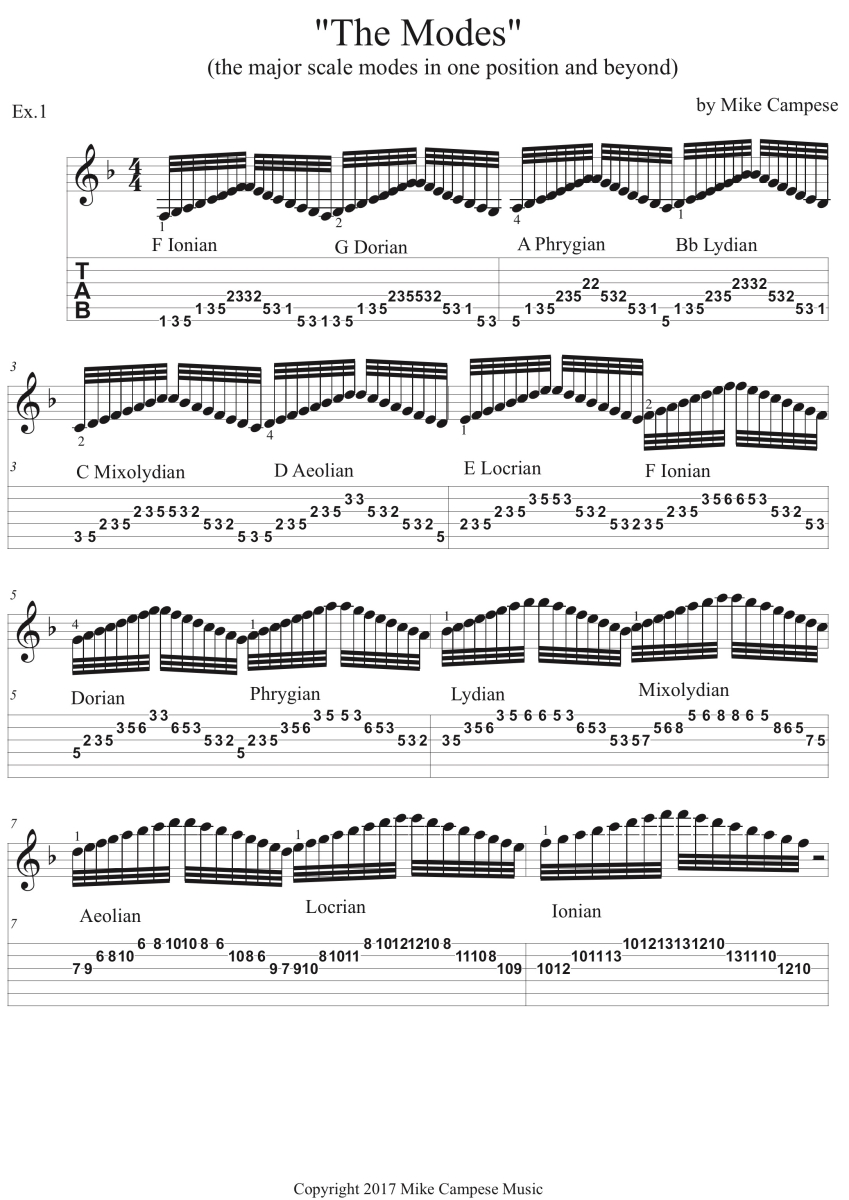Hello everyone! I'm just fresh off a tour of Italy and back this month with a new lesson for you. When you have been playing and teaching for as long as I have, you really see clearly what people need and overlook. One thing, for some reason, the modes have people confused, and it can have to do with how it is taught. Also, skipping over important information, not memorizing them properly and not playing them over a drone or one chord to hear the sounds of each one, to just name a few more issues.
Over the years I have written a bunch of lessons on the modes and I went into great detail on them. I won't get into great detail in this lesson, but I just want to show you a way you can practice the modes that may help. In this lesson, we will be focusing on the major scale modes in F major (F, G, A, Bb, C, D, E) and we will play all 7 modes in one pattern or position. This approach works in every pattern and in every key (see Example 1. You will notice, I do go higher up the neck out of the position when it gets to the C, It makes it easier to play at higher speeds. Next, take the Dorian mode pattern and play all 7 modes in that, do this for all the patterns.
The reason why I'm focusing on this area is because, when students are learning the patterns for each mode, they think the mode is only that one pattern. For example, they think the Dorian pattern is only Dorian and they don't realize you can play all 7 modes right inside of it. 7 modes, 7 patterns in the modern way, makes sense, you can play every mode in each of the 7 patterns. If you are doing the older style method based from the pentatonic, it is 5 patterns.
This may be a review for some of you, but I see this a lot and students eyes light up when they do this. Again, I think is has to do with how it is taught with the mode patterns and not knowing the intervals for the modes as well. Eventually, you have to have the intervals and notes memorized for each mode in every key and you won't have to rely on patterns. The guitar is a very pattern-based instrument and it can be limiting if you only base it off patterns. Be sure to learn the modes inside and out, memorize the names of the modes, the intervals, and the sound of each one as well. Here is a brief primer of the modes to review.
MP3 - The Modes In One Position - Example 1

"Modes" is another name for scales formed from the major scale (parent scale). You can form a mode by playing a major scale and starting from different notes in the scale. For example, say we begin with a C major scale (C, D, E, F, G, A, B), C is our root. If we play the same notes from D to D and make D the root, it becomes a D Dorian scale. Still using the same notes, if we start with the 3rd note, E, then we will have a E Phrygian scale. Here is the order and the formulas for each mode:
1. Ionian = 1, 2, 3, 4, 5, 6, 7
2. Dorian = 1, 2, b3, 4, 5, 6, b7
3. Phrygian = 1, b2, b3, 4, 5, b6, b7
4. Lydian = 1, 2, 3, #4, 5, 6, 7
5. Mixolydian = 1, 2, 3, 4, 5, 6, b7
6. Aeolian = 1, 2, b3, 4, 5, b6, b7
7. Locrian = 1, b2, b3, 4, b5, b6, b7
OK, that is it for this lesson. As always experiment, this topic is endless, and be sure to visit www.mikecampese.com for more information, and to purchase my CDs.
Mike Campese is an all-around music performer, session artist and teacher competent in many musical styles, electric and acoustic. He has studied at G.I.T. (Honors Graduate), and with Paul Gilbert, Norman Brown, Stanley Jordan, Scott Henderson and Keith Wyatt.